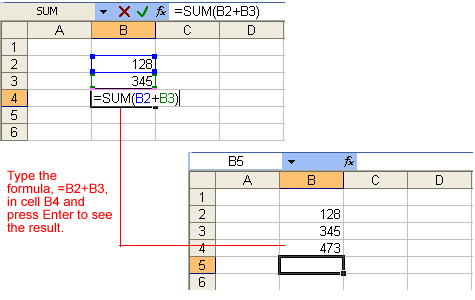Mastering the Arithmetic Symphony: A Comprehensive Guide to Creating Simple Formulas in Microsoft Excel 2003

Introduction:
Microsoft Excel 2003, a venerable member of the spreadsheet software pantheon, has been a stalwart companion for users seeking to perform calculations and data analysis. At the heart of Excel’s computational prowess lies the ability to create simple formulas—a fundamental skill that empowers users to transform raw data into meaningful insights. In this exhaustive guide, we embark on a comprehensive exploration of creating simple formulas in Excel 2003, unraveling the mathematical symphony that enables users to orchestrate their data with precision and finesse.
Section 1: Understanding the Formula Language
1.1 Formulas as the Building Blocks: Excel’s formula language is the backbone of its computational capabilities. Delve into the concept of formulas as expressions that perform calculations, linking cells and ranges to derive meaningful results.
1.2 The Anatomy of a Formula: Uncover the structure of a formula, comprising mathematical operators, cell references, and constants. Explore the role of operators such as addition (+), subtraction (-), multiplication (*), and division (/) in constructing formulaic expressions.
Section 2: The Basics of Creating Formulas
2.1 Initiating Formula Entry: Excel 2003 provides multiple avenues for initiating formula entry. Explore the basics of creating formulas by manually entering expressions into cells, understanding the role of the equals sign (=) as the formula initiator.
2.2 Utilizing the Formula Bar: Understand the Formula Bar as a dedicated space for formula entry and editing. Explore how this feature enhances the visibility and precision of formula creation, offering a comprehensive view of the formula being entered.
Section 3: Arithmetic Operations in Formulas
3.1 Addition and Subtraction: Delve into the foundational arithmetic operations of addition and subtraction within Excel formulas. Learn how to construct formulas that sum or subtract values from individual cells or ranges.
3.2 Multiplication and Division: Explore the intricacies of multiplication and division operations in Excel formulas. Master the art of creating formulas that involve multiplying or dividing values, fostering precision in mathematical calculations.
Section 4: Working with Cell References
4.1 Relative Cell References: Excel’s default referencing system is relative, allowing formulas to adapt dynamically as they are copied to different cells. Understand the concept of relative cell references and how they contribute to formula flexibility.
4.2 Absolute Cell References: Delve into the nuances of absolute cell references, a valuable tool for fixing specific cell locations within formulas. Learn how to use dollar signs ($) to create absolute references, ensuring the stability of certain values in repeated calculations.
Section 5: Basic Mathematical Functions
5.1 SUM Function: The SUM function is a cornerstone of Excel’s mathematical toolkit. Explore how to use the SUM function to quickly calculate the total of a range of numbers, streamlining the process of summing values within a dataset.
5.2 AVERAGE Function: Understand the AVERAGE function, a powerful tool for calculating the mean of a set of values. Explore how this function simplifies the process of deriving the average value within a range of cells.
Section 6: Formulas with Constants
6.1 Including Constants in Formulas: Beyond cell references, Excel formulas can incorporate constants to perform calculations. Learn how to integrate numerical constants directly into formulas, enhancing the flexibility and adaptability of mathematical expressions.
6.2 Mathematical Expressions with Constants: Explore the creation of more complex formulas by combining constants and cell references within mathematical expressions. Uncover how this approach allows users to perform intricate calculations with precision.
Section 7: Nesting Formulas
7.1 The Power of Nesting: Excel 2003 supports the nesting of formulas, allowing users to embed one formula within another. Delve into the concept of nested formulas and understand how they facilitate complex calculations by breaking them into manageable steps.
7.2 Practical Examples of Nesting: Explore practical examples of nesting formulas, such as calculating discounts, tax amounts, or compounded interest. Uncover the step-by-step process of nesting formulas to address real-world scenarios in financial and data analysis.
Section 8: Auditing Formulas
8.1 Formula Auditing Tools: Excel 2003 provides auditing tools for evaluating and troubleshooting formulas. Explore features like Trace Precedents and Trace Dependents, which help users understand the relationships between cells and identify potential errors.
8.2 Error Checking: Understand how Excel’s error checking tools can assist in identifying and rectifying common formula errors. Explore techniques for navigating error messages and ensuring the accuracy of formulaic expressions.
Section 9: Customizing Formulas
9.1 Formatting Formulas: Excel allows users to format formulas to enhance readability and presentation. Delve into techniques for formatting formulas, including line breaks, indentation, and color coding, ensuring clarity in complex expressions.
9.2 Formula AutoComplete: Explore the Formula AutoComplete feature, a time-saving tool that assists users in entering functions and formula elements. Understand how this feature enhances efficiency by providing suggestions and reducing manual input.
Section 10: Applying Formulas Across Worksheets
10.1 Copying Formulas Across Worksheets: Excel’s versatility extends to copying formulas across different worksheets within a workbook. Learn how to replicate formulas seamlessly, promoting consistency and efficiency in data analysis spanning multiple sheets.
10.2 Linking Formulas Between Workbooks: Excel 2003 enables users to link formulas between different workbooks. Explore the process of creating external references to formulas, fostering collaboration and data consistency across multiple Excel files.
Conclusion:
In conclusion, creating simple formulas in Excel 2003 is a fundamental skill that empowers users to unlock the full potential of spreadsheet software. This comprehensive guide has traversed the landscape of arithmetic operations, cell references, mathematical functions, and advanced formulaic techniques. By mastering the art of creating formulas, users can orchestrate their data with precision, transforming raw information into insightful analyses. As Excel 2003 continues to stand as a testament to timeless functionality, its robust features for formula creation empower users to navigate the arithmetic symphony of spreadsheet software with finesse and proficiency.







